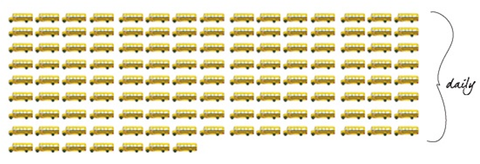The Thing About Plastic

The Other Kind of Drinking Problem
Many of us spent the summers of our youth sipping our favorite bubbled beverages through straws of every size and shape, from straight to bendy to corkscrew.
We used straws because they made drinks more fun. Straws made it possible to ride a bike and gulp soda without blocking your own view or rolling over a bump and inhaling the cup. At the time, we had no idea that those straws helped protect our teeth from the acids in those drinks. The catch is that those very same straws are still sitting in a landfill today.
Traditional plastic straws are one-time-use, and cannot be recycled, so they wind up in landfills and our oceans as little micro-particles. This is when our fish end up eating them and we end up eating the fish with plastic. By the year 2050 there will be more plastic in the ocean than fish if our habits don't change!

While one individual straw doesn’t create an environmental disaster, it’s the scale that creates an issue - in the United States alone, over 500 million disposable plastic straws are used and thrown away every year. Our straw use fills more than 127 school buses daily, or more than 46,400 school bus loads per year. (40ft. – long buses)*

If it's been a while since you've been on a school bus, think of it as enough straws to fill Yankee Stadium over 9 times a year!

*The number of disposable straws distributed for use in the US were provided by straw manufacturers estimates. While this estimate may sound high, many environmental groups believe that these numbers are low, as it does not include straws that are attached to juice boxes and milk cartons. http://bestrawfree.org.
Plastic Facts
- Bisphenol A or better known as BPA, is a chemical building block used to make polycarbonate plastic and epoxy resins. Studies have linked BPA to hormone disruption, increased breast and prostate cancer cell growth, and early onset puberty, and obesity.
- Some plastics slowly leak harmful chemicals into everything they touch. Whether it's through your one-time use water bottle, children's toys or household products, we know that Plastic Sucks!
- Most plastic straws cannot be recycled in average recycling centers so even if you put your straw in the recycling, it will still end up in a landfill.
- Plastic doesn't biodegrade, it photo-degrades, which means the material breaks into tiny little toxic pieces. These are found in our soils, waterways and even inside the fish we eat!
- That means that every piece of plastic that has been made still exists in some shape or form!
- The only way to get rid of this toxic threat is to strive to not use plastic in your everyday life.
While it might seem like a small step, by eliminating plastic straws from your habit, you can save 30,000 straws from landfills and waterways in your lifetime! You don't have to stop sucking, just switch to a reusable glass straw instead!


